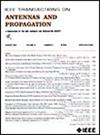Air-Filled High-Efficiency W-Band Metasurface Antennas Using the Microcoaxial Additive Manufacturing Process
IF 5.8
1区 计算机科学
Q1 ENGINEERING, ELECTRICAL & ELECTRONIC
引用次数: 0
Abstract
Millimeter-wave and terahertz antennas require high manufacturing precision and low dielectric loss. As a new solution, micrometal additive manufacturing (M-MAM) technology can achieve multilayer pure copper structure, with planar pattern precision of up to采用微同轴增材制造工艺的充气高效率w波段超表面天线
毫米波和太赫兹天线需要高制造精度和低介电损耗。微金属增材制造(m - mam)技术作为一种新的解决方案,可以实现多层纯铜结构,平面图案精度可达$5~\mu $ m。本文采用一种新的九层m - mam工艺流程制备了w波段超表面天线。在电铸过程中,天线结构的大型金属和空白区域被周期性的矩形金属柱取代,以平衡晶圆上的静电场。这些结构变化保证了层厚的均匀性,有助于减少误差的积累。测得天线的10db阻抗带宽为22.5%, and a maximum peak gain of 13.7 dBi is achieved in an overall aperture size of $1.43 \lambda _{0} \times 0.88 \lambda _{0}$ . In addition, the front-to-back ratio (FBR) of the metasurface antenna is larger than 20 dB across the whole bandwidth. Thanks to the M-MAM technology that nearly eliminates the dielectric loss, the antenna achieved a maximum simulated radiation efficiency of 96%.
本文章由计算机程序翻译,如有差异,请以英文原文为准。
求助全文
约1分钟内获得全文
求助全文
来源期刊
CiteScore
10.40
自引率
28.10%
发文量
968
审稿时长
4.7 months
期刊介绍:
IEEE Transactions on Antennas and Propagation includes theoretical and experimental advances in antennas, including design and development, and in the propagation of electromagnetic waves, including scattering, diffraction, and interaction with continuous media; and applications pertaining to antennas and propagation, such as remote sensing, applied optics, and millimeter and submillimeter wave techniques

 求助内容:
求助内容: 应助结果提醒方式:
应助结果提醒方式:


